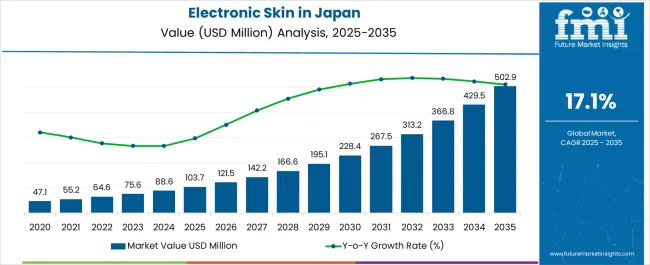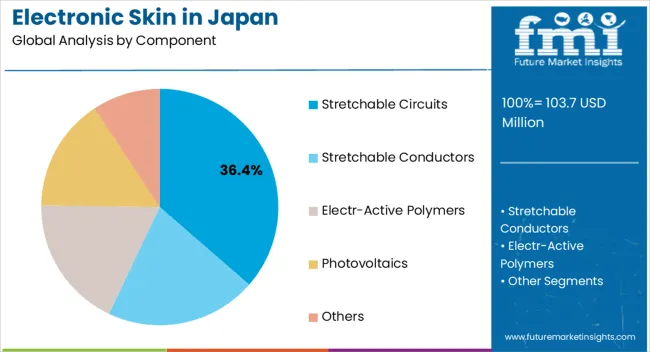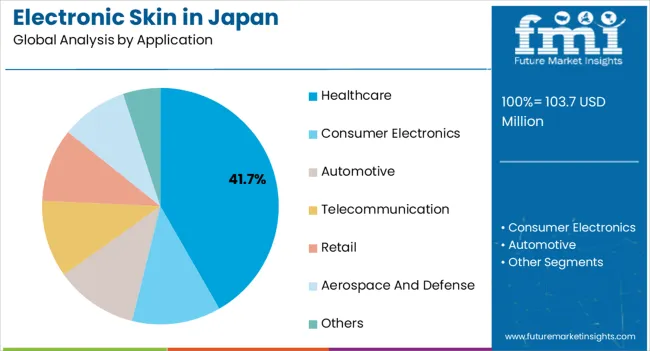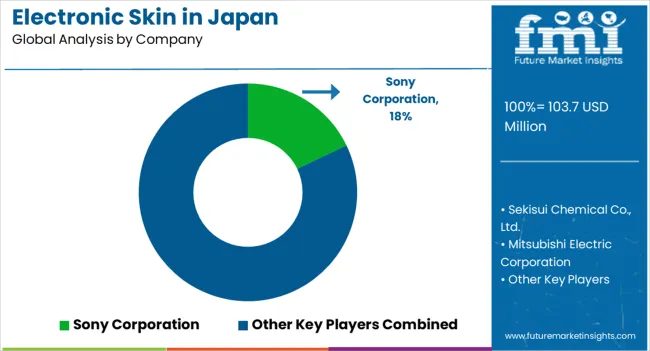The Industry Analysis of Electronic Skin in Japan is estimated to be valued at USD 103.7 million in 2025 and is projected to reach USD 502.9 million by 2035, registering a compound annual growth rate (CAGR) of 17.1% over the forecast period.

| Metric | Value |
|---|---|
| Industry Analysis of Electronic Skin in Japan Estimated Value in (2025 E) | USD 103.7 million |
| Industry Analysis of Electronic Skin in Japan Forecast Value in (2035 F) | USD 502.9 million |
| Forecast CAGR (2025 to 2035) | 17.1% |
The electronic skin market in Japan is experiencing notable growth. Rising demand for wearable electronics, increasing adoption of advanced healthcare monitoring systems, and technological advancements in flexible materials are driving market expansion. Current market dynamics are characterized by integration of highly sensitive sensors, robust data transmission capabilities, and miniaturized electronic components.
Regulatory support for medical-grade wearable devices and government initiatives promoting smart healthcare are enhancing market accessibility. The future outlook is shaped by the convergence of robotics, prosthetics, and personalized health monitoring, which is expected to increase adoption of electronic skin technologies across healthcare and industrial applications.
Growth rationale is underpinned by the capability of electronic skin to provide real-time monitoring, improve patient outcomes, and enable high-precision sensing Continuous innovation in materials science, stretchable electronics, and manufacturing processes, combined with strong industrial and healthcare infrastructure in Japan, is expected to sustain market expansion and broader commercialization over the forecast period.

The stretchable circuits segment, accounting for 36.4% of the component category, has maintained a leading position due to its flexibility, durability, and compatibility with wearable and prosthetic devices. Adoption has been supported by advancements in conductive materials, mechanical stability, and integration with sensor arrays.
Market preference has been reinforced by the ability of stretchable circuits to maintain performance under repeated deformation, which is critical for healthcare monitoring and robotics applications. Manufacturing improvements and regulatory compliance have strengthened reliability and product acceptance.
Strategic collaborations between electronics developers and medical device manufacturers have facilitated wider adoption Ongoing research in novel substrates and miniaturized circuit designs is expected to expand applicability, sustain competitive positioning, and ensure continued contribution to the overall market share.

The healthcare application segment, representing 41.7% of the application category, has remained dominant due to increasing integration of electronic skin in patient monitoring, rehabilitation, and diagnostics. Adoption has been driven by rising demand for non-invasive, real-time physiological monitoring and precision healthcare solutions.
Market growth has been supported by supportive government initiatives, clinical validation studies, and reimbursement frameworks for wearable medical devices. Continuous improvements in sensor accuracy, signal processing, and biocompatibility have enhanced reliability and acceptance among healthcare professionals.
Expansion of hospitals, clinics, and home healthcare infrastructure has further reinforced segment prominence Ongoing innovation and commercialization of healthcare-focused electronic skin devices are expected to sustain market share and contribute significantly to overall market growth in Japan.
In Japan, the electr-active polymers section leads the electronic skin technology component category, with a significant CAGR of 23.5% through 2035.
Owing to their versatility and responsiveness, electr-active polymers are gaining interest in applications ranging from healthcare to robotics. Their ability to mirror the sensory functions of human skin forces the segment leadership upwards.
| Segment | Segment Share |
|---|---|
| Electr-active Polymers | 32.9% |
| Stretchable Conductors | 29.2% |
Meanwhile, it is followed by the stretchable conductors segment, which accelerates at a CAGR of 21.7% over the forecast period. The stretchable conductors segment holds a strong position. The electronic skin in Japan appears promising, with a steady growth trend driven by advances in material science and rising demand across multiple industries.
Diverse sectors compete for prominence in Japan's developing landscape of electronic skin applications. Consumer electronics takes the lead, with a stunning CAGR of 23.5% through 2035. The advancing integration of e-skin in wearable devices and smart gadgets, in response to the desire for more fabulous user experiences and health monitoring, contributes to consumer electronics domination.
| Segment | Segment Share |
|---|---|
| Consumer Electronics | 23.5% |
| Retail | 18.9% |
During the projected period, the retail segment ought to expand at an 18.9% CAGR. Retailers are utilizing electronic skin for unique customer engagement, personalized shopping experiences, and inventory management. The retail sector's adoption is aided by the constantly evolving retail scenario, highlighting the vitality of technology-driven solutions.
The sales forecast for e-skin applications in Japan remains positive, driven by continued technical breakthroughs, favorable government efforts, and a growing older population in need of healthcare solutions. Telecommunications, healthcare, aerospace, and defense are primed for significant growth, supporting a dynamic ecosystem of innovation and expansion across multiple industries.

Electronic skin manufacturers primarily focus on creating cutting-edge materials, sensors, and manufacturing processes to improve the performance and functionality of electronic skin systems.
Several significant players have emerged due to Japan's well-established electronics sector and robust infrastructure for research and development. Domestic electronic skin businesses utilize their knowledge of wearable technology, nanomaterials, and sensor technologies to achieve a competitive advantage.
Collaborations with academic institutions and government programs strengthen research and development endeavors for e-skin.
International firms are actively joining the Japan industry, contributing to expanding rivalry and technological interchange. To compete in the competitive field, enterprises in Japan must focus on differentiation and quality as demand for electronic skin applications in healthcare, robotics, and consumer electronics continues to climb.
Recent Developments Observed in Electronic Skin in Japan
Strategic Partnership for Advancing Switch mRNA Therapies Launched by Nitto and aceRNA in December 2024
Nitto Denko Corporation and aceRNA Technologies Co., Ltd. have joined forces to develop Switch mRNA therapy. Nitto has made an undisclosed investment in aceRNA. AceRNA uses the RNA Switch, created by Kyoto University's Hirohide Saito, to regulate mRNA functionalities based on microRNA activity. It makes disease therapy more exact.
The cooperation aims to improve mRNA therapy and license it to pharmaceutical companies following verification by September 2025.
Nitto, Astellas, and M. Heart Unite for Innovative ECG Testing Service
Nitto Denko Corporation, Astellas Pharma Inc., and M. Heart Co., Ltd have signed a memorandum of agreement for an ECG testing service. The disposable EG Holter ECG device, which Astellas is going to sell in Japan, was created and manufactured by Nitto.
M. Heart to handle marketing permission and supply data analysis via MYHOLTER II. The EG Holter is comfortable for patients and is clean, light, and waterproof. The partnership intends to support early identification and treatment of atrial fibrillation, a key healthcare concern in Japan, resulting in longer, healthier lives.
| Attribute | Details |
|---|---|
| Estimated Valuation (2025) | USD 103.7 million |
| Projected Valuation (2035) | USD 502.9 million |
| Anticipated CAGR (2025 to 2035) | 17.1% |
| Historical Analysis of Electronic Skin in Japan | 2020 to 2025 |
| Demand Forecast for Electronic Skin in Japan | 2025 to 2035 |
| Quantitative Units | Revenue in USD million and CAGR from 2025 to 2035 |
| Report Coverage | Revenue Forecast, Company Ranking, Competitive Landscape, Growth Factors, Trends and Pricing Analysis |
| Key Companies Profiled | Sekisui Chemical Co., Ltd.; Mitsubishi Electric Corporation; Panasonic Corporation; Nitto Denko Corporation; Sony Corporation |
The global industry analysis of electronic skin in Japan is estimated to be valued at USD 103.7 million in 2025.
The market size for the industry analysis of electronic skin in Japan is projected to reach USD 502.9 million by 2035.
The industry analysis of electronic skin in Japan is expected to grow at a 17.1% CAGR between 2025 and 2035.
The key product types in industry analysis of electronic skin in Japan are stretchable circuits, stretchable conductors, electr-active polymers, photovoltaics and others.
In terms of application, healthcare segment to command 41.7% share in the industry analysis of electronic skin in Japan in 2025.






Full Research Suite comprises of:
Market outlook & trends analysis
Interviews & case studies
Strategic recommendations
Vendor profiles & capabilities analysis
5-year forecasts
8 regions and 60+ country-level data splits
Market segment data splits
12 months of continuous data updates
DELIVERED AS:
PDF EXCEL ONLINE
Industry 4.0 Market
Industry Analysis Non-commercial Acrylic Paint in the United States Size and Share Forecast Outlook 2025 to 2035
Industry Analysis of Syringe and Needle in GCC Size and Share Forecast Outlook 2025 to 2035
Industry Analysis of Medical Device Packaging in Southeast Asia Size and Share Forecast Outlook 2025 to 2035
Industry Analysis of Paper Bag in North America Size and Share Forecast Outlook 2025 to 2035
Industry Analysis of Lidding Film in the United States Size and Share Forecast Outlook 2025 to 2035
Industry Analysis of Automotive Lightweight Body Panel in the United States Size and Share Forecast Outlook 2025 to 2035
Germany Outbound Tourism Market Trends – Growth & Forecast 2024-2034
Europe Second-hand Apparel Market Growth – Trends & Forecast 2024-2034
Industry Analysis of Last-mile Delivery Software in Japan Size and Share Forecast Outlook 2025 to 2035
Industry Analysis of Electronic Skin in Korea Size and Share Forecast Outlook 2025 to 2035
Industry Analysis of Electronic Skin in Western Europe Size and Share Forecast Outlook 2025 to 2035
DOAS Industry Growth in the United States – Trends & Forecast 2024-2034
FIBC Industry Analysis in Japan Size and Share Forecast Outlook 2025 to 2035
Western Europe Pectin Market Analysis by Product Type, Application, and Country Through 2035
Pectin Industry Analysis in Japan Size and Share Forecast Outlook 2025 to 2035
Mezcal Industry Analysis in Korea – Trends, Demand & Industry Growth
Mezcal Industry Analysis in Western Europe Report – Growth, Demand & Forecast 2025 to 2035
Asia Pacific Dental Market Analysis – Growth, Trends & Forecast 2024-2034
Mezcal Industry Analysis in Japan - Consumer Demand & Industry Trends in 2025

Thank you!
You will receive an email from our Business Development Manager. Please be sure to check your SPAM/JUNK folder too.
Chat With
MaRIA